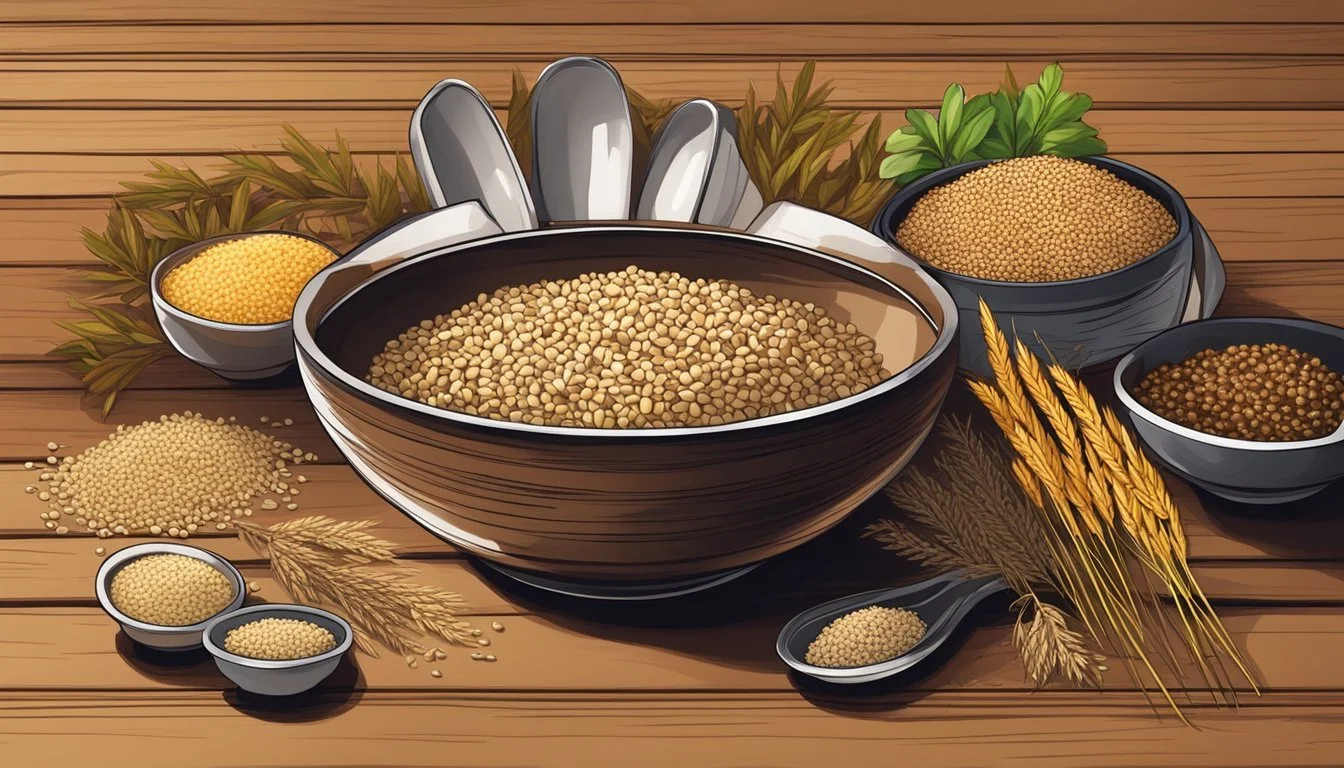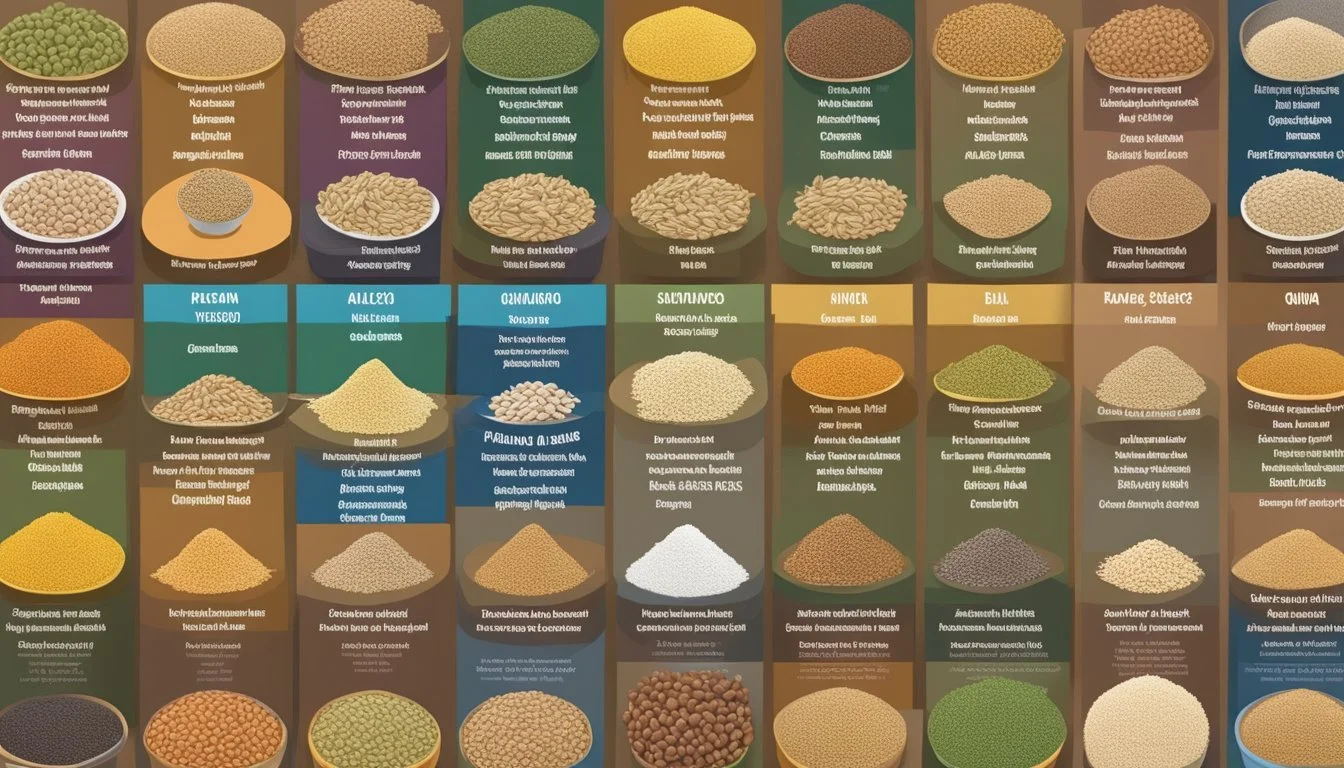Barley Substitutes
Top Alternatives for Your Recipes
Barley is a versatile grain commonly used in a variety of dishes, from soups and stews to salads and pilafs. Its nutty flavor and appealing chewy texture make it a favorite for adding substance and a wholesome aspect to meals. However, there are numerous reasons one might seek a substitute for barley, whether due to dietary restrictions, gluten intolerance, or simply a lack of availability. Understanding alternative grains and ingredients that mimic barley's characteristics can help in maintaining the integrity of a dish while catering to different needs.
Several grains and seeds stand out as top contenders for replacing barley in recipes. Quinoa offers a similar nutritional profile with the added benefit of being a complete protein, making it an excellent choice for those looking for a more protein-rich option. Buckwheat and farro, though distinct in their own right, can mimic barley's texture and are praised for their versatility in the kitchen. When the aim is to maintain the heartiness of a dish, options such as brown rice and oats can be employed to achieve a result close to that of barley's contribution. These substitutes not only preserve the essence of traditional barley-based dishes but also offer an array of flavors and nutritional benefits, making the culinary exploration both enjoyable and healthful.
Understanding Barley
Before exploring substitutes, it's essential to have a clear understanding of barley itself, its nutritional contents, and its role in diets. This section outlines what barley is and its nutritional profile, which contributes to its health benefits.
What Is Barley?
Barley is a versatile cereal grain that has a rich nutty flavor and an appealing chewy texture. It's widely used in soups, stews, salads, and as a rice substitute. In addition to its culinary uses, barley is also processed into barley malt for use in brewing and in a variety of food products.
Nutritional Profile of Barley
Barley is well-regarded for its high fiber content, which aids in digestion and contributes to cardiovascular health. It's also a considerable source of protein, which is vital for muscle repair and growth. Barley contains a variety of important vitamins and minerals, including:
Magnesium: Important for muscle function and bone health.
Iron: Essential for the transportation of oxygen in the blood.
B Vitamins: Crucial for energy metabolism within the body.
Selenium: A powerful antioxidant that plays a critical role in the maintenance of immune system health.
The specific nutritional values of barley per 100 grams are listed below in tabulated form:
Nutrient Amount Fiber 15.6g Protein 9.9g Magnesium 79mg Iron 2.5mg B Vitamins Varied Selenium 22.3μg
Barley's rich nutrient profile contributes to its recognition as a wholesome grain that supports overall health.
Barley's Role in Diet
Barley is a versatile grain commonly used in a myriad of dishes ranging from salads to soups. It's a source of dietary concern for individuals with gluten intolerance or celiac disease since barley contains gluten.
Barley in Culinary Uses
Barley is often incorporated into various recipes due to its chewy texture and mildly nutty flavor. It excels in several culinary applications:
Soups and Stews: Its ability to absorb flavors makes it a nourishing addition to broth-based dishes.
Salads and Pilafs: Barley adds a satisfying heft and texture to these lighter dishes, making them more substantial.
Barley’s culinary flexibility allows it to be a primary ingredient in a breadth of international cuisines.
Dietary Concerns with Barley
While barley is nutritious, it presents dietary challenges for some individuals:
Celiac Disease: Barley contains gluten, making it unsuitable for those with celiac disease.
Gluten Intolerance: Similar to celiac disease, individuals with gluten intolerance must also avoid barley to prevent adverse reactions.
For those who cannot consume gluten, identifying gluten-free substitutes that can mimic barley's characteristics in recipes is crucial.
Alternatives to Barley
Finding the right barley substitute can enhance your cooking experience by providing similar textures or nutritional profiles. This section breaks down substitutes into those that cater to gluten-free needs, match barley's nutritional content, or mimic its texture.
Gluten-Free Barley Substitutes
For those looking to recreate barley's role in recipes without gluten, a variety of grains are at your service:
Quinoa: Packed with protein and fibers, quinoa is a nutritional powerhouse and a perfect gluten-free option.
Buckwheat: Despite its name, buckwheat is gluten-free and offers a robust flavor with a comfortable chewiness.
Millet: This small, round grain provides a mild, slightly nutty flavor and is versatile in a range of dishes.
Rice: From brown rice's close nutritional profile to white rice's neutral palette, rice options can replicate the bulk of barley in recipes.
Nutritionally Comparable Substitutes
Several grains match up to barley's nutritious value and are substantial enough to stand in for it in most dishes:
Farro: While not gluten-free, farro boasts a similar nutty flavor profile and protein content, matching barley not just nutritionally but also texturally.
Oats: Offering a high fiber content, oats can serve as a health-conscious substitute. Be sure to check for gluten-free labels if necessary.
Brown Rice: It brings a similar profile of nutrients, with good amounts of proteins and fibers, and works well in place of barley with little adjustment.
Similar Texture Substitutes
Texture can be as critical as taste in a substitute. Some grains ensure that the heartiness of barley is not missed:
Farro: With a chewy bite, farro is a barley twin in terms of texture, making it a fantastic choice for soups and salads.
Wheat Berries: These whole wheat kernels offer a chewy texture and work well in pilafs or as a barley stand-in for grain salads.
Oats: Rolled oats or steel-cut oats provide a texture that, while distinct, can lend a satisfying mouthfeel akin to barley's chewiness in various recipes.
Detailed Overview of Substitutes
In seeking alternatives to barley, individuals prioritize gluten-free options, nutritional value, and flavor compatibility. This section details four substitutes that each bring unique qualities to dishes traditionally prepared with barley.
Quinoa as a Substitute
Quinoa, a seed revered for its high protein content and complete amino acid profile, serves excellently as a barley substitute. It's gluten-free and offers a similar chewy texture, making it suitable for various applications, from soups to salads. Quinoa's subtle nutty flavor pairs well with a range of ingredients, and it's also rich in fiber, vitamins, and minerals, which contribute positively to its overall nutritional value.
Farro: An Ancient Grain
Farro, an ancient grain with a satisfying chewy texture and nutty flavor, is comparable to barley but is not gluten-free. It boasts a higher fiber and protein content than most other grains, enhancing the nutritional profile of dishes. With its robust structure, it holds up well in soups, stews, and salads, providing a hearty component that retains a pleasant bite.
Buckwheat: A Versatile Option
Despite the name, buckwheat is actually a gluten-free pseudocereal related to rhubarb and sorrel. It presents a rich, earthy flavor and a soft yet grainy texture once cooked. Buckwheat is known for its high levels of minerals and antioxidants, with nutritional benefits that include improved heart health and blood sugar regulation. It can be ground into flour or used whole, adapting well to a variety of recipes.
Millet's Mild Flavor
Millet, with its subtle, mild flavor profile, acts as a gluten-free alternative to barley that doesn't overpower dishes. It's a small seed with a light, fluffy texture when cooked and can be toasted to enhance its flavor. Rich in vitamins and minerals, millet provides an excellent source of fiber and protein, making it a nutritious addition to meals that traditionally feature barley.
Cooking with Barley Substitutes
When choosing a barley substitute, the key considerations are ensuring a similar texture and cooking qualities in the final dish, whether it's soups, stews, or salads. The chosen substitute should complement the flavors of the other ingredients in the recipe.
Substitute Ratios and Preparation
Each barley substitute has unique preparation steps and ratios. Here's a concise guide:
Quinoa: Use a 1:1 ratio for pearl barley. Rinse quinoa before cooking to remove any bitterness.
Farro: Substitute equal amounts for barley. It needs to be soaked overnight and cooked longer than barley.
Brown Rice: Use a 1:1 ratio. Brown rice has a chewier texture and takes longer to cook than white rice.
Millet: Substitute in a 1:1 ratio for barley. Toasting millet before cooking can enhance its nutty flavor.
Adapting Recipes for Substitutes
Adapting recipes to accommodate barley substitutes requires attention to cooking times and liquid amounts.
In soups and stews, barley acts as a thickener. Substitutes like brown rice and farro might not thicken as much, so one might need to adjust the amount of broth.
For side dishes, such as salads, each grain brings a distinct flavor and texture. Tasting and adjusting seasoning can ensure that the final dish maintains its intended flavor profile.
It's essential to consider the cooking time of the substitute, as it may differ from barley. For example, millet cooks quicker than barley, while farro takes a bit longer.
By making these adjustments, one can seamlessly incorporate barley substitutes into various recipes while maintaining the integrity of the dish.
Health Benefits of Substitutes
When exploring the health benefits of barley substitutes, one must consider both gluten-free alternatives and the rich nutrient profiles they offer.
Benefits of Gluten-Free Grains
Grains that are naturally gluten-free provide options for those with celiac disease or gluten sensitivity. Quinoa, buckwheat, and millet are prominent gluten-free substitutes for barley that bring a variety of health benefits.
Quinoa: A complete protein containing all nine essential amino acids, rich in fiber, magnesium, B vitamins, iron, potassium, calcium, phosphorus, vitamin E, and various beneficial antioxidants.
Buckwheat: Despite its name, buckwheat is not related to wheat and is gluten-free. It is high in fiber and contains both protein and essential minerals like magnesium and iron.
Millet: This gluten-free grain provides a good source of fiber, protein, and nutrients such as magnesium and phosphorus.
These alternatives not only allow those avoiding gluten to enjoy similar dishes that typically contain barley but also contribute significantly to their daily nutritional requirements.
Macro and Micronutrient Profiles
Barley substitutes also possess diverse macro and micronutrient profiles that can complement or even enhance a balanced diet.
Protein: Both quinoa and farro offer high protein content, which is crucial for muscle repair, growth, and overall metabolism.
Fiber: Integral for digestive health, all substitutes like quinoa, farro, millet, and buckwheat are high in dietary fiber, assisting in blood sugar control and satiety.
Magnesium and Iron: These minerals are vital for numerous bodily functions, including oxygen transport and energy production. Barley substitutes serve as an excellent source of both.
Vitamins: B vitamins, essential for energy production and creating new cells, are abundant in these grains.
Below is a table highlighting the nutrient composition of the mentioned barley substitutes per cooked cup (approximately):
Grain Protein (g) Fiber (g) Magnesium (mg) Iron (mg) Quinoa 8.1 5.2 118 2.8 Farro 6.0 7.0 60 2.0 Buckwheat 5.7 4.5 86 1.3 Millet 6.1 2.3 76 1.1
These alternatives not only enable individuals to maintain a gluten-free diet but also to take advantage of a broad spectrum of health-supportive nutrients.
FAQs on Barley Substitutes
When seeking alternatives to barley, especially for soup recipes or when considering a replacement with rice, it becomes essential to understand the cooking properties and flavor profiles of potential substitutes.
What Can You Use Instead of Barley in Soup?
In soups, quinoa serves as an excellent replacement for barley due to its complete protein content and it adds a comparable thickness. It should be used in a 1:1 ratio for pearl barley.
Brown rice also makes for a suitable substitute. It's rich in fiber, contributes to the heartiness of soups, and maintains a satisfying chewiness. Brown rice should be simmered until it has a tender, chewy consistency, similar to the usual texture desired from barley in soups.
Another option is farro, which has a nutty flavor and a chewy texture comparable to barley. However, one should be mindful that farro may require slight adjustments in liquid content in recipes.
Can You Replace Barley with Rice?
Barley can be substituted with different forms of rice. Brown rice is preferred for its high fiber content and firmer texture. With a cooking time approximately ranging from 30-45 minutes, it offers a chewiness similar to that of barley.
White rice is another possible substitute, although it has a softer texture and less fiber. It cooks faster, usually in about 18-20 minutes, and can work when a lighter substitute is acceptable.
Ultimately, whether one uses quinoa, farro, or rice as barley substitutes, each brings unique characteristics to a dish and can often be used interchangeably with some consideration to their individual cooking times and nutritional content.




